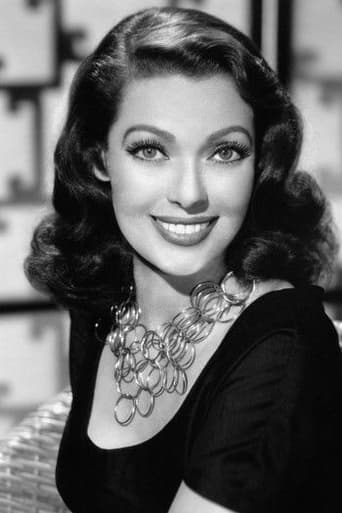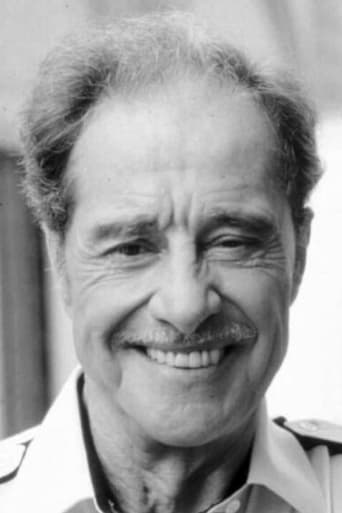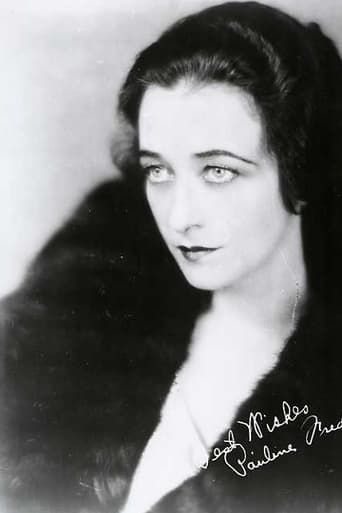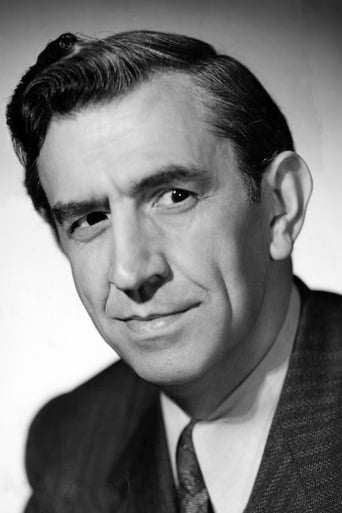vincentlynch-moonoi
You have a choice to make. You can fret about Don Ameche playing an Indian and let it ruin the film for you. Or you can just accept that in 1936 there wasn't going to be a full blooded Indian in a leading role of an important motion picture. In other words, get over it.This film is based on a very important novel about racial prejudice, and while I have not read the novel, my impression is that to quite an extent the movie is a too-simplified version of the story. However, racial prejudice in an underlying and ongoing theme of this film, so it still has impact.The other important thing about this film is that it was only the fourth movie to be filmed in 3-strip Technicolor! Unfortunately, the print is not pristine, but the Technicolor is still quite stunning, including with lots of outdoor scenes "on location" in sunny California.Loretta Young was a lovely actress, and her performance here is excellent. Don Ameche, a much forgotten actor, was a fine performer, although here he seems perhaps a bit too refined to be a Spanish-Indian of that period. I don't know that...I'm just surmising. He's still interesting to watch. The other performance of note here is by Jane Darwell, whom most viewers will recall from "The Grapes Of Wrath".When you think of the advances in Technicolor from this film in 1936 to "Gone With The Wind" 3 years later...wow! The film does seem dated, but I think it's worth it to watch an historically important novel turned into a film, with themes that still resonate in our culture today.
weezeralfalfa
This film and the slightly prior "Trail of the Lonesome Pine" became pioneer projects in using the rather recently perfected 3 strip Technicolor filming process in extensive outdoor scenes. Both films deal with conflicts between rural folk: the one between clans of 'hillbillies' in the Appalachians, while this one deals with the generally callus treatment of California Indians and Latinos by recent American immigrants into the recently conquered upper California territory. Based upon the immensely popular and critically acclaimed Helen Jackson 1884 novel of the same title, it's essentially a remake of the 1928 film, again of the same title. All copies of this prior film were believed lost until recently. It starred the famous Mexican actress Dolores del Rio: a considerably less controversial choice than the non-Latin Loretta Young in the present film. This film must have been made just after Loretta had her hushed up out-of-wedlock child with Clark Gable.Unfortunately, I only saw the last half of the film during one of its rare TV showings, thus will have to rely on other info to fill in the first half of the story. Briefly , Ramona is the daughter of a Spanish landowner and a deceased Indian maiden, raised by this family along with son Felipe, who falls in love with her.(In the novel, she's an adopted orphan). However, she falls in love with an Indian hired hand: Alessandro, played by Don Ameche, in his first significant film role: another controversial casting decision. Opposed by her stepmother, they elope, married by a sympathetic, humorous, priest, played by long-lived character actor Victor Kilian. Obviously, some time has passed before the next scene, when they are tending their farm and have an infant. Two Americans ride up to chat with them, one played by Russell Simpson. Alessandro brags about the agricultural quality of his land, and the two move on to San Diego. A while later we see several neighboring houses on fire, and one Indian shot dead after resisting a demand that he vacate his homestead, now claimed by Americans. Soon, Simpson shows up with a similar demand of the young couple. Ramona convinces Alessandro it's best to give in. So, they burn their nearly ripe corn and wheat, abandon their livestock, and load a wagon to travel to who knows where? During a fierce rainstorm in the mountains, they encounter a house and ask for shelter. 'Aunt' Ri Hyar(Jane Darnell)invites them in, thinking they are Mexicans down on their luck. Clearly, she's a very different kind of American(and rare women) from those previously encountered. However, she takes fright when she figures out Alessandro is Indian rather than Mexican. However, when they claim to be Christians, she reverts to her friendly attitude.Unfortunately, their infant comes down with a fever. Ri directs Alessandro to the only doctor, far away. But the doctor is overwhelmed, treating the victims of an epidemic, and refuses to make the trip. However, he supplies some medicine and instructions. Alessandro's horse develops leg problems on the strenuous trip 'home'. Thus, an alternative horse is needed. A farm is encountered, but the American owners are not found. Thus, Alessandro 'borrows' one of their horses. The owners arrive as he gallops off in the opposite direction. The owner(played by famous character actor John Carradine)rides after him. Alessandro gives the infant the medicine as instructed, then goes to a spring for water. Carradine arrives, and Ramona, mistaking him for the doctor, directs him to Alessandro, whom he immediately shoots dead, no questions asked. During the funeral procession, Aunt Ri gives Ramona a long, encouraging, talk, then Felipe(Ramona's familial brother)arrives and they embrace. We are left with the suggestion that Felipe will become her new husband or act as her guardian in the meanwhile(In the novel, he becomes her husband, after a much messier last portion of the story than this film version).Despite much casting criticism by many, I believe Loretta was an excellent choice for Ramona. In the novel, she is described as black haired, with blue eyes, which fits. Loretta was a well established film actress of uncommon beauty and sympathy, as brought out in her concern for her child...Novelist Jackson wanted to portray CA Indians as 'noble savages'. Hence, the classy Ameche was a good choice for Alessandro, if a bit wooden and rather unbelievable as a shepherd. Kent Taylor: sort of a second tier Gable-type is OK as Felipe. But, the most ingenious casting was Jane Darwell as aunt Ri Hyar, who, no doubt, represents what author Jackson would have been like in her situation. In contrast to the male Americans, she welcomes Indians and Mexicans as potential friends, as long as they claim to be Christians. She equates Christianity with being civilized(a very questionable assumption, as history proves!). Her long comforting speech to the recently widowed Ramona serves as a warm-up for her parting speech in her most famous role: as Ma Joad, in "The Grapes of Wrath". She's just as impressive here. In fact, the last half of this film rather mirrors this later film, but from a Native American point of view.This film long predates much more famous westerns(such as "Broken Arrow" and "The Searchers") that provide a similar overall theme that Americans and Indians(or Latinos) best respect each other, and sometimes intermarry. Ramona symbolizes this in her hybrid origins, and in taking an Indian husband, despite her privileged Spanish upbringing, as well as a subsequent Spanish husband. Murderous, thieving, prejudiced Americans are the bad guys.Ameche and Loretta would be reteamed a few years later as the romantic couple in the more remembered B&W "The Story of Alexander Graham Bell".
MartinHafer
Back in the 1930s and 40s, Hollywood was extremely insensitive (and stupid) about casting folks for minority roles. However, that was the time and you just need to keep your politically correct instincts in check when you watch this one! Imagine.....Loretta Young playing a woman who is half American Indian and half Mexican! While this sounds dumb, understand that the likes of Rock Hudson played Indians in films--or Don Ameche cast as a full-blooded native like he is in "Ramona"!! As for J. Carrol Naish--like Anthony Quinn, he played just about everything (except blacks) in films--so it isn't surprising he's in this one playing a Mexican. Plus, frankly, he's played so many nationalities, most everyone at the time had no idea what his heritage really is!! But Loretta Young and Don Ameche--with their lovely American diction (especially Ameche, who is practically the epitome of politeness and class)!!! What were the executives thinking (or smoking)?! "Ramona" must have been a prestige picture for 20th Century-Fox, as it is filmed in beautiful 1930s-style Three-Strip Technicolor--a HUGE expense at the time and something reserved only for the best films. In fact, it was the first such film made by the studio.When the film begins, Ramona is in love with a cultured man from a very good family. So does she....or so she thinks. Eventually the truth is discovered--she's a half-breed! And she's forced to leave her home by some real jerk-faces. But before she goes, her native friend (Ameche) tells her that he's loved her--and she is thrilled, as she loves him, too. So, they run away together and get married. However, their life is tough, as folks are quite prejudiced towards them--throwing them off their farm. Can they somehow find a place that will accept the strangely cultured couple--and their new baby?! Overall, I'd say the writing isn't bad (but it is a bit schmaltzy) and the film manages to be watchable in spite of some terrible casting.By the way, if you want to see other films with equally ridiculous casting, try finding "The Conquerer" (with John Wayne as Genghis Khan and red-headed Susan Hayward as his bride, Bortai)--or most any Charlie Chan film.




